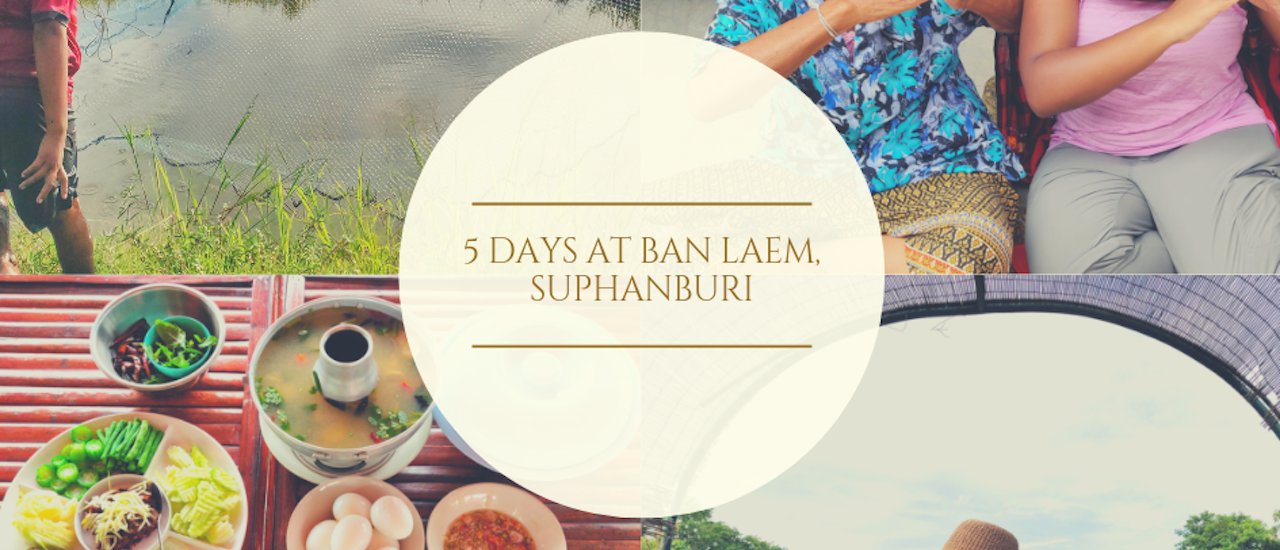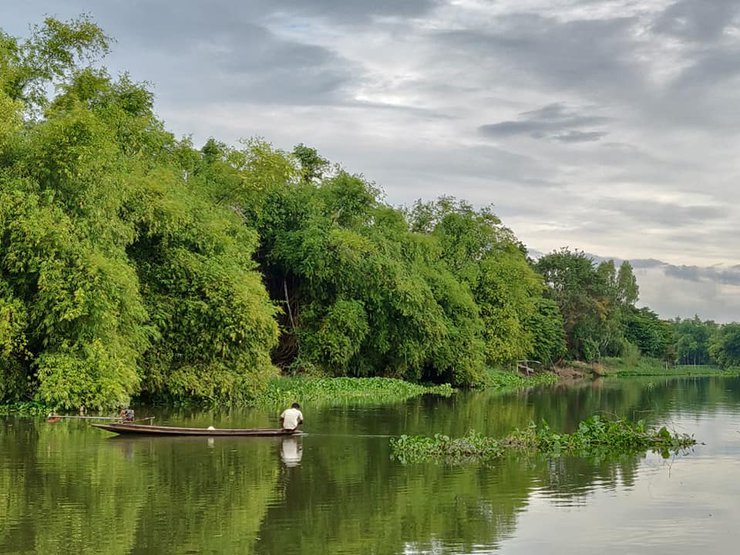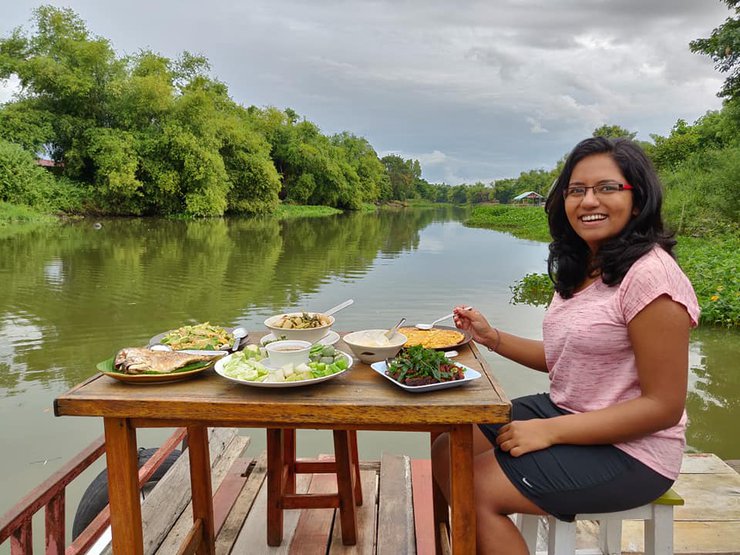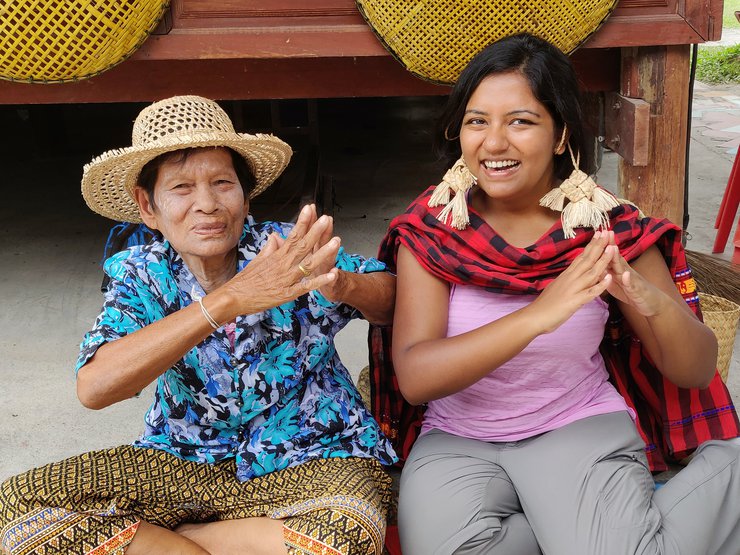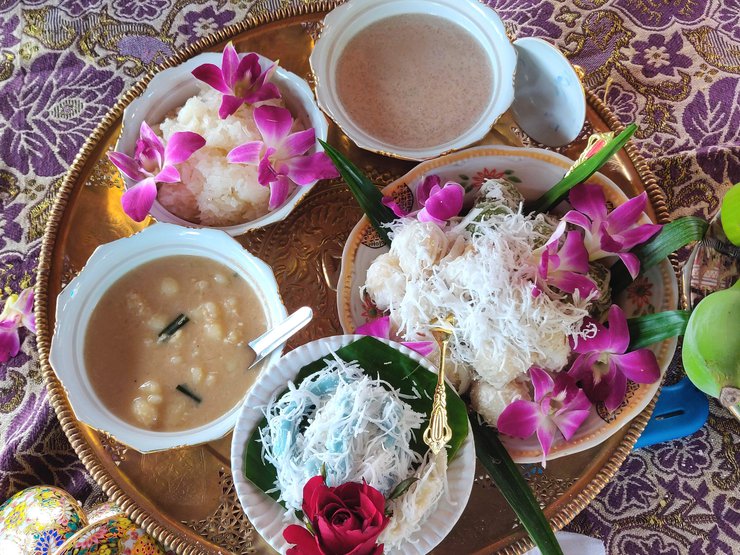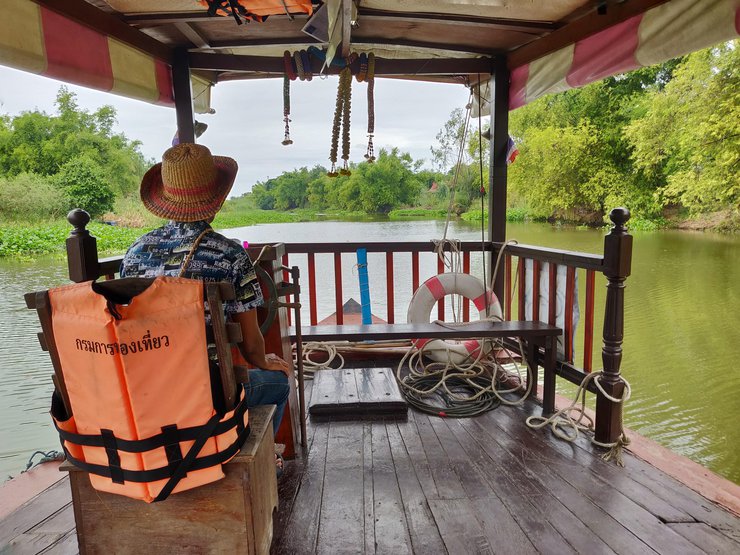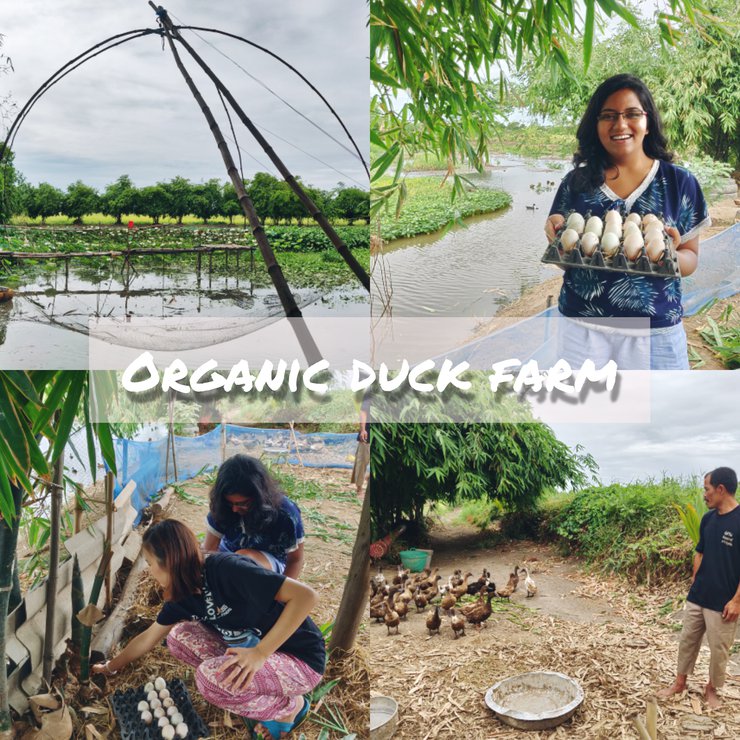Less than 2 hours’ drive away from the bustling city of Bangkok lies Ban Laem village. It is an old community founded during the late Ayutthaya period (1350 to 1767) with traditional Thai houses built along the Suphanburi river. It was also known as the Angwa troop passage during the great war between Burma and Siam.

There are plenty of things to be said about Ban Laem, starting from the warm welcome ceremony to the lush greenery all around that can immediately calm any restless traveler. However, as I spent a week in this village, I began to notice a trend. A trend that would delight many sustainability advocates.
A sustainable lifestyle
This little community has pretty much replaced plastic straws and bags with ones made from various aquatic and riverside plants. For example: the stem of water hyacinths (an aquatic plant) is sun-dried and used to make a variety of household items including souvenirs, bags and purses.

During our welcome ceremony, we were given beautiful hats. At first, I thought they were as good as the fancy flimsy Instagram hats we have all seen before. But when I actually held one, it felt very sturdy. That’s when I found out that these hats are locally made from the water hyacinth too.

As dinner is served, our host informs us that the vegetables are organically grown. “Natural, natural” - he emphasises. The fish is caught fresh from the river which flows peacefully right beside the local homestay we have been allocated. Even the warm colourful drink we are served is extracted from a plant. Small leftovers from dinner are fed to the fish in the river.
Small steps can go a long way in saving our mother earth.
Taking care of mother nature

The river is an integral part of the life of the people of Suphanburi. In many ways, it is their source of livelihood. As such, each member of the community follows a responsible lifestyle. There is no designated person who cleans the river. And yet, the river seemed surprisingly clean.
“Who cleans the river, then?” – I asked my local host curiously.
“Everyone. Whoever sees any garbage cleans it!” – Piboy, my host casually replied. “Tomorrow, I will show you how to clean the river.” – Piboy continued.

Hence, we woke up the next day and hopped on a small boat to clean the river. We were given a long hook which is used to drag the garbage towards the boat and a knife – should we require to drain the water from plastic bags to make them light before picking them up. We rowed around for an hour or so and collected all the garbage we could find.
Respect for mother nature is ingrained into the society. Compare this to today’s modern societies where most individuals would not consider it their duty to respect (much less try to clean up) natural resources.
Holding onto age-old traditions
If you happen to visit Bangkok like 20.5 million tourists do every year, then it’s easy to get lost in the glittery nightlife and forget Thailand’s age-old traditions. Green curry, pineapple fried rice and mango sticky rice steal the limelight at dinner tables and traditional Thai food like Khanom Tom Khao and Khanom Khan Hlaw have become a thing of the past.
Food brings people together, it always has. In Ban Laem, this idea continues to flourish. During our stay in Ban Laem, we had the opportunity to learn how to make traditional Thai Chilli Paste, a local variety of Tom Yum soup, Khanom Chao Ban Chao Ruen, Thong pub, Kue Rokok, Khanom Normai and Kembang Goyang.
While each of these deserve a separate blog of its own, the one that’s truly worth mentioning is Khanom Chao Ban Chao Ruen.
I consider myself a big foodie and a dessert aficionado. I have made it my personal mission to try as many local cuisines as possible around the world. And I can tell you with deep confidence that not many desserts come close to Khanom Chao Ban Chao Ruen.

Khanom Chao Ban Chao Ruen are considered auspicious desserts in Thailand. Usually there are 5 varieties served on a plate: Khanom Tom Khao, Khanom Tom Dang, Khanom Khan Hlaw, coconut milk, and sticky rice.
As I go around the plate and let my tongue taste each of these distinctly flavoured desserts, my heart is filled with happiness. Each of them tastes better than the previous one. The soul of a foodie is now at peace.

With our stomachs full, we take a boat ride to explore the Suphanburi river and our host delights us with a traditional song. I didn’t understand a single word but sometimes it’s not necessary. The tune conjured up an image of fishermen fishing and rowing their boats in my mind. Our host confirmed this image. He told us that back in the days, there was no other form of entertainment, so the fishermen sang songs to keep themselves busy. “If a guy likes a girl, then he would sing for her too.” - My local guide added. We joked about how this norm would be highly ridiculed if any man dares to carry it out today! “We would call him crazy or something” – We all laughed.
As our modern society races forward, many traditions are forgotten, and many aspects of our lifestyles change. Arguably, some of it change for the better but in the process, we lose a lot of valuable aspects of our life too. For instance, the idea cooking and eating together every day and truly enjoying each dish is an art that seems have gotten lost. The idea of sitting on a boat and singing traditional songs is a lifestyle that is quickly becoming extinct. And yet, when a city dweller like me delves into this quaint lifestyle, she finds herself experiencing emotions that she did not know she was capable of.
Self-sufficiency
Have you ever wondered if you would survive if you were left on a Robinson Crusoe island? If you had asked me a week earlier, I would have confidently said no. Now, perhaps I am one step closer to survival, thanks to a week of a variety of lessons at Ban Laem.
This tiny village has shown me what it means to be self-sufficient. During our time here, we learnt how to grow organic vegetables, how to grow and make salted duck eggs, how to make incense sticks, and how to make brooms out of coconut trees.
Organic vegetable farm – all our food is grown here

Over the last few days, we have been eating delicious meals every day. Now, it was time to find out where they come from. Our host took us to an organic farm nearby. “All our food is grown here.” – he said. It was perhaps not far from the truth, considering anything from chilis and lime to lentils and pumpkin could be found here.

After two rounds of plucking, we now had enough raw materials to cook our own lunch, which we had already learnt before!
Organic duck farm and making salted duck eggs

At the heart of this tiny village lies another organic farm. Ducks are the main focus, but the farm also grows a multitude of vegetables, chicken, and fish. As soon as we arrived, 3 dogs rushed towards us. The furriest and cutest one was called “Choo”!
Here, all animals seemed to live freely and peacefully. As we walked inside, we found a pond where the ducks were freely roaming around. We met the guy who raises the ducks. After he greeted us, he made a unique sound and almost immediately, the ducks started following us. “He can talk to the ducks” – Our local guide commented playfully.
We carefully collected duck eggs and placed them in the holder. Salted duck eggs are yet another delicacy of Ban Laem village. The complete version almost resembles a fancy soap, so we were curious to see how to make this.

We were told to mix white clay powder with tons of salt. Then, we proceeded to chop and make a paste of Pandan leaves to extract the green coloured water from them. This coloured water was added to the clay powder and salt mixture. We got our hands dirty and mashed the mixture together for a while.

Coat two separate eggs with this mixture and then put them together and join them with the help of this sticky mixture. Rub the surface and roll it till the two eggs are steadily joint together. Now take a plate of chopped Pandan leaves and roll the eggs over it, letting the leaves stick to the eggs.
Voila, your salted double duck eggs are now ready! Keep them for about 10 days before you use it to make fried eggs and 15 days if you make boiled eggs.
Making broomstick from coconut trees
If you thought the Ban Laem community was self-sufficient only in terms of food, think again! After a lavish spread of lunch, we went to meet an old man who taught us how to make brooms out of coconut trees.

For this, first you must choose an aged leaf and slice out the midrib of the leaf, leaving behind the petals. The midribs are then left to dry in the sun for a couple of days. Once ready, they are tied together in small bunches.
To make a broom, you have to skilfully tie at least 7-8 small bunches together, making sure the rope is as tight as possible! We had now learnt yet another life skill.
Incense stick making class
Incense sticks are useful, not just for offering prayers but also to keep away mosquitoes and other flies.
While the number of ingredients is plenty, the process is fairly straightforward. Mix equal amount of flour, a powder obtained from corn, lemongrass water, Pandan leaves water, the residue of coffee and sawdust (wood powder) to make a paste. The paste will resemble clay in texture. Colours are usually added using natural ingredients from various plants. Apply this paste on a bamboo stick and rub it with wet hands to even it out. If the strokes are right, the incense stick will soon be ready for drying!
Here, every day, we work hard, but the work is different. Unlike my life back in Singapore, here we actually grow and collect the raw materials for our food and then cook our own food. We make other items that we would require during our daily life. There is a certain sense of satisfaction that comes from being self-sufficient. Perhaps, that’s what I will miss the most about Ban Laem.
Away from the city, into the lap of mother nature

My mind is calm here. We wake up every morning and sit by the river that flows beside our homestay. Every day is breakfast with a view. The days are filled with a variety of activities – an attempt to learn the local way of life. The evenings often end with a bicycle ride among the rice fields. Just one look at the various shades of green is good enough to soothe any restless soul.

Although village life has its own charm, I have often wondered if I can ever call such a place home. Being born and brought up in big cities, despite the chaos and the stress, I am perhaps a bit too accustomed to the conveniences and choices the city life offers.
However, after spending 5 days at Ban Laem village, as I pack my bags, I feel a strong sense of belonging. I don’t want to leave. Of course, this is a natural feeling for most travelers, but this time, it’s more than that. As days passed by, this place began to feel like home. The cheerful people whose language I didn’t understand began to seem like family. We learnt their way of life, one day at a time and they took care of us, like family would.
The 5 days I spent at Ban Laem were filled with activities. We had so much to do that we rarely had a moment to breathe. And yet, every time I was on a boat cruising on the waters of Suphanburi river, my mind was strangely at peace. The fresh wind refreshed my soul. My mind was devoid of thoughts, something that never happened during my city life, no matter how hard I tried.

I think I am beginning to like the farm life.
Where religion is not forced upon you
I have not been a religious person for the better part of my adult life. If anything, I would consider myself agnostic or a free thinker. While most countries have a religious majority, people like me are often frowned upon. Not visiting a temple or a mosque or a church regularly can attract many critics. Naturally, a lot of people tend to be religious, just for the societal pressure and upbringing alone.

In Ban Laem, despite the Buddhist majority, religion is not forced upon you. It is peaceful, as every religion should be. You are welcome to practise or not.

In such a setting, I actually enjoyed visiting a few temples, not for the purpose of praying but for seeking a peaceful place to calm my mind. Along the way, we met delightful monks who told us the history of the temple and the town, we learnt about why a particular temple had 88 bells (8 resembling infinity is considered auspicious in Buddhism) and took part in a traditional fortune telling ritual -- all without feeling any pressure to actually follow Buddhism.
Live and let live seems to be the mantra at Suphanburi.
Concluding thoughts - a head full of questions

As we come to the end of our journey, my mind is filled with thoughts. I can’t help but think how much this community focuses on a sustainable and self-sufficient lifestyle without even realising it! No, this is not an experimental home where a bunch of like-minded sustainability advocates have come together to craft a mindful lifestyle. Ban Laem simply sticks to its old ways. It also upholds ancient traditions that binds the community together.
This brings me to the question: is our society progressing backwards? If we continued along to live the way our ancestors did, would our mother earth be better off? If we stuck to our traditions, would we be happier today as human beings?
Now, these are interesting questions - especially coming from a person who has never really given such issues much of a thought. However, I am convinced that change needs to be gradual.
The idea that sustainability is not a new trend that we all need to follow, but rather an old way of life that we should go back to is perhaps a good enough first step. The idea that self-sufficiency and traditions can strengthen our community is perhaps a close second step.

Perhaps, one day, I can actually consider the big step of moving my life to a small village. Until then, I continue to learn valuable lessons from each trip and hopefully incorporating some of them into my daily city life.
P.S: Don't forget to watch the highlights of my journey at the full vlog below!
Madhurima Dutta
Monday, July 29, 2019 8:07 PM

